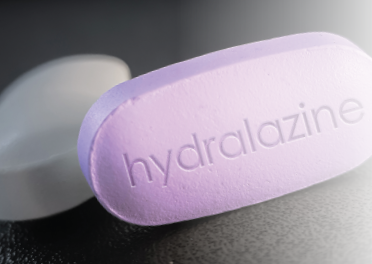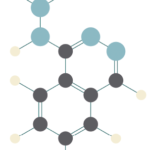
Sonis Photography / shutterstock.com
Hydralazine has been in use as a treatment for hypertension, most notably in heart failure patients, since 1951.1 The drug is a known cause of autoimmune disease, most specifically hydralazine-induced lupus.
Hydralazine-induced lupus occurs in 7–13% of those taking the medication.2-4 It often presents with constitutional symptoms, arthritis/arthralgias, cutaneous lesions, serositis, myalgias and/or hepatomegaly. Features of severe systemic lupus erythematosus, such as cytopenias, nephritis and central nervous system involvement, are not common in hydralazine-induced lupus.
Systemic vasculitis as a consequence of treatment with hydralazine is considerably rarer than hydralazine-induced lupus. Signs and symptoms of drug-induced vasculitis include constitutional symptoms, cutaneous vasculitis and arthritis/arthralgias.5 Severe cases can result in rapidly progressing, multi-organ damage, including necrotizing glomerulonephritis and alveolar hemorrhage. Treatment begins with the prompt withdrawal of hydralazine, and patients may also require corticosteroids and immunosuppressive therapy.
In this case report, we detail an example of hydralazine-induced anti-neutrophil cytoplasmic antibody (ANCA) associated vasculitis precipitating pulmonary-renal syndrome, the most immediately life-threatening potential complication of this condition. Our case is especially notable due to the high titers of MPO- and PR3-ANCA seen in this patient, titers higher than we have seen reported previously in association with hydralazine-induced ANCA-associated vasculitis.
Case Presentation
A 66-year-old Black man presented to the hospital due to low-flow alarms from his left ventricular assist device (LVAD). He’d had an LVAD for three-and-a-half years due to ischemic cardiomyopathy. His medical history also included a chronic line infection, requiring suppressive antibiotics. He had hypertension, hyperlipidemia, diet-controlled diabetes mellitus and stage 4 chronic kidney disease (CKD) with secondary anemia.
Our patient had been treated with 100 mg of hydralazine three times a day for the past four years. He was taking other medications, but none that are known to cause drug-induced lupus or ANCA-associated vasculitis.
The patient reported hemoptysis, which dated back a couple of months and was intermittent in nature. He also reported dyspnea on exertion, which had progressively worsened during the past year. He denied any fever, rash, nasal congestion, myalgia, arthralgia, urinary symptoms, or gastrointestinal bleeding.
Upon arrival, he was found to have a supratherapeutic INR (international normalized ratio) of 3.9. He quit smoking four years ago, but had a 45 pack-year history. The physical exam was unremarkable, apart from bibasilar crackles. Upon arrival, he received intravenous fluids and his LVAD flow numbers improved.
Initial labs were significant for a hemoglobin of 9.0 g/dL and hematocrit of 27.7%. Blood urea nitrogen (BUN) and creatinine were elevated at 73 mg/dL and 5.9 mg/dL, up from baselines of 33 mg/dL and 3.0 mg/dL. Urinalysis showed 3+ blood with >100 RBC per high power field, and 1+ protein. The protein/creatinine ratio was slightly elevated at .44.
Anti-nuclear antibody (ANA) titer was elevated at 1:1280, with a homogenous pattern, and a rheumatologist was consulted to rule out a possible vasculitis or other inflammatory process. ANCA serology showed a significant increase in proteinase 3 (PR3) titer (167 units/mL; normal <20 units/mL) and myeloperoxidase (MPO) titer (100 units/mL; normal < 20 units/mL). Additionally, our patient tested positive for anti-histone antibodies and lupus anticoagulant. Anti-glomerular basement membrane, anti-dsDNA, anti-Smith, anti-SSA, anti-SSB, anti-cardiolipin, anti-beta-2 glycoprotein 1 and anti-ribonuclear protein antibodies were all negative. C3 and C4 levels were within normal ranges, at 78 and 16, respectively.
Hepatitis B surface antigen, hepatitis C antibody, and HIV 1 and 2 antibody tests were also negative. His erythrocyte sedimentation rate (ESR) and C-reactive protein levels were elevated at 90 mm/hr and 40.7 mg/L, respectively.
During his hospital stay, the patient was noted to have progressive renal dysfunction and increased hemoptysis, amounting to about half a cup in volume daily. A CT scan of the chest was performed for hemoptysis workup, which demonstrated bilateral groundglass opacities with a somewhat perihilar distribution (see Figure 1, above). Hemoptysis persisted despite improvements in both left ventricular function and INR. Bronchoscopy and kidney biopsy were not performed because the patient was deemed to be at high risk given his high oxygen requirements and hemodynamic instability. Despite not receiving transbronchial or renal biopsies, he was presumptively started on treatment for ANCA-associated vasculitis.
Hydralazine was promptly discontinued, and the patient was treated with high-dose, intravenous methylprednisolone, followed by 60 mg of oral prednisone daily. He was concurrently treated with plasma exchange and one subsequent dose of intravenous 500 mg/m2 cyclophosphamide infusion.
On repeat testing, his inflammatory markers improved (i.e., his ESR fell to 10 mm/hr, down from 90 mm/hr). His hemoptysis also transiently improved; however, he then developed hemolytic anemia caused by LVAD dysfunction. The LVAD was found to be clotted, requiring it to be turned off.
The patient was ultimately discharged to hospice care.
Discussion
Hydralazine-induced ANCA-associated vasculitis is a rare complication of hydralazine therapy that cannot be missed. It can present with ANA, ANCA and anti-histone positivity, along with a pulmonary-renal syndrome that causes rapid clinical deterioration.6,7 Anti-cardiolipin and beta-2-glycoprotein IgM positivity have been reported, but these associations are not universal. Complement levels can be normal, but have been reported low in some cases.8 Systemic symptoms may or may not be present, and when present typically mirror those seen in hydralazine-induced lupus.
Our patient presented with a positive ANA, MPO- and PR3-ANCAs, anti-histone antibody, and lupus anticoagulant. He presented with hemoptysis and acute kidney injury. He was unique in his markedly elevated titers of both MPO- and PR3-ANCAs despite an overall lack of systemic symptoms.
In a previous case report, Agarwal et al. suggest that both MPO- and PR3-ANCA may play a role in this disease.9
Systematic vasculitis as a consequence of treatment with hydralazine is considerably rarer than hydralazine-induced lupus.
An extensive literature search yielded only two previously reported patients with hydralazine-induced ANCA-associated vasculitis who expressed significant PR3-ANCA positivity.10 PR3 titers were 52 units/mL (normal <20 units/mL) and 56 units/mL, compared with 167 units/mL in our patient. In the aforementioned two patients, MPO-ANCA was either weakly positive (23 units/mL) or negative. Our patient demonstrated marked positivity for both MPO- (100 units/mL, normal <20/mL) and PR3-ANCA (167 units/mL). We could not find such high titers of both MPO- and PR3-ANCA in any previously reported case of hydralazine-induced vasculitis.
Formal diagnostic criteria have not yet been published for hydralazine-induced vasculitis. In one study, Kumar et al. highlight the overlapping features of hydralazine-induced lupus and hydralazine-associated vasculitis. They suggest that hydralazine-associated autoimmunity exists on a continuum. Patients with hydralazine-induced vasculitis may possess some clinical and laboratory findings of drug induced-lupus. However, hydralazine-induced vasculitis is unique in its rapid progression and pulmonary and renal involvement. Laboratory findings differ; hydralazine-induced vasculitis is associated with ANCA positivity, in addition to a positive ANA and the presence of anti-histone antibodies. Anti-histone antibodies are not typically seen in ANCA-associated vasculitis that does not involve hydralazine. In most cases, ANCA positivity was predominantly due to antibodies against MPO.
Renal and pulmonary biopsies should be conducted when there is a suspicion for hydralazine-induced ANCA-associated vasculitis. The results of a renal biopsy aid greatly in diagnosing hydralazine-induced ANCA-associated vasculitis and differentiating this condition from hydralazine-induced lupus. Renal biopsy has revealed a pauci-immune glomerulonephritis in all patients with hydralazine-induced ANCA-associated vasculitis who have been biopsied, with or without evidence of focal small artery and arteriolar fibrinoid necrosis.11,12
Kumar et al. suggest these findings support the notion that hydralazine-induced ANCA-associated vasculitis is a process that is subacute or chronic, rather than acute. In hydralazine-induced lupus, on the contrary, renal biopsy demonstrates immune complex deposition. Without a renal biopsy, we technically cannot definitively rule out hydralazine-induced lupus in favor of hydralazine-induced vasculitis.
There was some consideration that our patient may have suffered from hydralazine-induced lupus, because this disease can be a cause of diffuse alveolar hemorrhage and hemolytic anemia. However, given the aggressiveness of our patient’s presentation in the form of diffuse alveolar hemorrhage and exacerbation of preexisting renal disease, coupled with highly elevated MPO- and PR3-ANCA titers, our suspicion was higher for vasculitis. Therefore, we felt confident in initiating treatment for hydralazine-induced ANCA-associated vasculitis without renal biopsy.
Although our patient lacked any clinical symptoms commonly associated with
hydralazine-induced lupus, such as arthralgias and cutaneous findings, we also acknowledge the possibility that our patient may have suffered from a combination of both hydralazine-induced lupus and hydralazine-induced ANCA-associated vasculitis.
Kumar et al. have presented the notion that patients with hydralazine-induced ANCA-associated vasculitis may simultaneously present with features of both drug-induced lupus and drug-induced vasculitis. In our patient, the only features commonly associated with hydralazine-induced lupus were a positive ANA, the presence of anti-histone antibodies and lupus anticoagulant positivity. These findings could also have been caused by long-term hydralazine use without concomitant hydralazine-induced lupus.
Transbronchial biopsy in hydralazine-induced ANCA-associated vasculitis may demonstrate pulmonary capillaritis, but it is not always performed. Gross hemoptysis is a less common symptom and may be indicative of more advanced disease. In mild disease, computed tomography (CT) scans of the chest typically reveal bilateral pulmonary infiltrates with or without pleural effusions. In severe cases, CT scans can show groundglass opacities concerning for diffuse alveolar hemorrhage.
Identified risk factors for hydralazine-induced ANCA-associated vasculitis include a cumulative dose of more than 100 g, longer duration of therapy, female sex, slow hepatic acetylation, the null gene for C4 and a history of thyroid disease.13,14
Hydralazine is known to cause autoimmunity. Several theories have been proposed addressing potential mechanisms by which hydralazine can induce ANCA-associated vasculitis. Accumulations of hydralazine in intracytoplasmic neutrophilic granules have been shown to bind to myeloperoxidase, which then causes apoptosis and the expulsion of intracellular material. Interaction between this material and antigen-presenting cells can cause the production of anti-neutrophil cytoplasmic antibodies and anti-nuclear antibodies.15
In a separate study, Magro et al. hypothesize that hydralazine interferes with neutrophil extracellular traps (NETs) and consequently enhances antigen exposure to antigen presenting cells.16
Others have hypothesized that hydralazine enhances the expression of neutrophil autoantigens by reversing the epigenetic silencing of MPO and PR3. It is also believed that slow acetylation of hydralazine and the resulting drug metabolites lead to the breakdown of central tolerance.17,18
Hydralazine-related drugs, such as dihydralazine and cadralazine, are known to cause drug-induced lupus; however, little information is present on their propensity to cause drug-induced ANCA-associated vasculitis. These drugs break down into metabolites that are known to inhibit myeloperoxidase activity.19 Therefore, one could reasonably assume that hydralazine-related drugs could potentially induce ANCA-associated vasculitis. However, more research would be needed to fully establish whether or not hydralazine-related drugs could be used as substitutes to potentially reduce or eliminate the risk of inducing ANCA-associated vasculitis.
When a diagnosis of hydralazine-induced ANCA-associated vasculitis is suspected, hydralazine, the disease-causing agent, should be promptly stopped due to the rapidly progressing nature of this disease. Timlin et al. have identified that hydralazine-induced ANCA-associated vasculitis may be associated with poor renal outcomes.20
A review of literature demonstrated no uniform therapy to treat hydralazine-induced ANCA-associated vasculitis. However, immunosuppressive regimens typically include a combination of both steroids and cytotoxic therapy. Treatments used have included methylprednisolone and prednisone for steroid therapy and cyclophosphamide or mycophenolate mofetil for cytotoxic therapy.
Our patient was treated with prednisone, cyclophosphamide and two pulses of methylprednisolone. Our patient also received a course of plasma exchange therapy. Plasma exchange was not uniformly performed in the patients that we reviewed and was generally reserved for more severe cases, if performed at all.
Prognosis is unclear in hydralazine-induced ANCA-associated vasculitis. Some patients underwent complete recovery, whereas others required immunosuppression indefinitely. The cause of these differences is likely multifactorial.
Our patient presented solely with hemoptysis and acute kidney injury. This patient may prove important in furthering our understanding of this rare but serious medication complication.
Our patient’s PR3-ANCA titer was highly elevated. This finding is consistent with the hypothesis by Agarwal et al. that PR3-ANCA, in addition to MPO-ANCA, may play a role in causing disease. Despite presenting without any of the common clinical symptoms of hydralazine-induced lupus, our patient also supports Kumar et al.’s recent presentation of the overlapping features between hydralazine-induced lupus and hydralazine-induced ANCA-associated vasculitis.
Caution should be exercised when prescribing hydralazine due to its potential to precipitate disease and the rapid deterioration associated with hydralazine-induced ANCA-associated vasculitis. Keasberry et al. suggest that it may be prudent to avoid using hydralazine in patients with a history of autoimmune disease and to regularly check the urine for red blood cells.21
When relevant, a kidney biopsy should be obtained, because a pauci-immune glomerulonephritis in the setting of long-term hydralazine use may be confirmatory when hydralazine-induced ANCA-associated vasculitis is suspected.
Further research is needed to fully understand the pathophysiology, risk factors and ideal treatment of this rare, but potentially deadly, complication of hydralazine use. Additional study may dictate whether or not it could be prudent to delay starting hydralazine in patients with or without heart failure due to its potential to cause serious autoimmune disease in the future.
 William J. Scheuing, MD, is an internal medicine resident at Virginia Tech Carilion School of Medicine, Roanoke.
William J. Scheuing, MD, is an internal medicine resident at Virginia Tech Carilion School of Medicine, Roanoke.
 Nitasha Kumar, MD, is a rheumatologist with Arthritis & Rheumatism Associates, in the Washington, D.C., area. She completed her rheumatology fellowship at Ochsner Medical Center, New Orleans.
Nitasha Kumar, MD, is a rheumatologist with Arthritis & Rheumatism Associates, in the Washington, D.C., area. She completed her rheumatology fellowship at Ochsner Medical Center, New Orleans.
 William Davis, MD, is the rheumatology department head and vice chair of education in the Department of Internal Medicine at Ochsner Health, New Orleans. He is a Master of the American College of Physicians and an ACR Fellow. He is also an associate professor for the University of Queensland, Brisbane/Ochsner Clinical School.
William Davis, MD, is the rheumatology department head and vice chair of education in the Department of Internal Medicine at Ochsner Health, New Orleans. He is a Master of the American College of Physicians and an ACR Fellow. He is also an associate professor for the University of Queensland, Brisbane/Ochsner Clinical School.
 Robert Quinet, MD, FACP, is the director of the Ochsner Rheumatology Fellowship Program, Ochsner Health, New Orleans, and holds a clinical professorship at Louisiana State University Health Sciences Center School of Medicine and a clinical assistant professorship at Tulane Medical Center, both in New Orleans. He is also an ACR Fellow.
Robert Quinet, MD, FACP, is the director of the Ochsner Rheumatology Fellowship Program, Ochsner Health, New Orleans, and holds a clinical professorship at Louisiana State University Health Sciences Center School of Medicine and a clinical assistant professorship at Tulane Medical Center, both in New Orleans. He is also an ACR Fellow.
References
- Khan MA. Effect of hydralazine in hypertension. Br Med J. 1953 Jan 3;1(4800):27–29.
- Finks SW, Finks AL, Self TH. Hydralazine‐induced lupus: Maintaining vigilance with increased use in patients with heart failure. South Med J. 2006 Jan;99(1):18–22.
- Xiao X, Chang C. Diagnosis and classification of drug-induced autoimmunity (DIA). J Autoimmun. 2014 Feb–Mar;48–49:66–72.
- Handler J. Hydralazine-induced lupus erythematosus. J Clin Hypertens (Greenwich). 2012 Feb;14(2):133–136.
- Taborda L, Amaral B, Isenberg D, et al. Drug-induced vasculitis. Adverse Drug Reaction Bulletin. 2013 Apr;279(1):1075–1078.
- Marina VP, Malhotra D, Kaw D. Hydralazine-induced ANCA vasculitis with pulmonary renal syndrome: A rare clinical presentation. Int Urol Nephrol. 2012 Dec;
44(6):1907–1909. - Namas R, Rubin B, Adwar W, et al. A challenging twist in pulmonary renal syndrome. Case Rep Rheumatol. 2014;2014:516362.
- Kumar B, Strouse J, Swee M, et al. Hydralazine-associated vasculitis: Overlapping features of drug-induced lupus and vasculitis. Semin Arthritis Rheum. 2018 Oct;48(2):283–287.
- Agarwal G, Sultan G, Werner S, et al. Hydralazine induces myeloperoxidase and proteinase 3 anti-neutrophil cytoplasmic antibody vasculitis and leads to pulmonary renal syndrome. Case Rep Nephrol. 2014;2014:868590.
- Zuckerman R, Patel M, Costanzo E, et al. Hydralazine-associated adverse events: A report of two cases of hydralazine-induced ANCA vasculitis. J Bras Nefrol. 2018 Apr–Jun;40(2):193–197.
- Babar F, Posner JN, Obah EA. Hydralazine-induced pauci-immune glomerulonephritis: Intriguing case series with misleading diagnoses. J Community Hosp Intern Med Perspect. 2016 Apr 25;6(2):30632.
- Dobre M, Wish J, Negrea L. Hydralazine-induced ANCA-positive pauci-immune glomerulonephritis: A case report and literature review. Ren Fail. 2009;31:745–748.
- Lionaki S, Hogan SL, Falk RJ, et al. Association between thyroid disease and its treatment with ANCA small-vessel vasculitis: A case–control study. Nephrol Dial Transplant. 2007 Dec;22(12):3508–3515.
- McKinnon RA, Nebert DW. Possible role of cytochromes P450 in lupus erythematosus and related disorders. Lupus. 1994 Dec;
3(6):473–478. - Hogan JJ, Markowitz GS, Radhakrishnan J. Drug-induced glomerular disease: Immune-mediated injury. Clin J Am Soc Nephrol. 2015 Jul 7;10(7):1300–1310.
- Magro CM, Momtahen S, Harp J. The distinctive histopathology of hydralazine- associated ANCA positive vasculitis: In vivo demonstration of NETosis. Eur J Dermatol. 2017 Feb 1;27(1):91–92.
- Somers EC, Richardson BC. Environmental exposures, epigenetic changes and the risk of lupus. Lupus. 2014 May;23(6):568–576.
- Chang C, Gershwin ME. Drugs and autoimmunity—a contemporary review and mechanistic approach. J Autoimmun. 2010 May;34(3):J266–J275.
- Nassberger L. The antihypertensive compounds hydralazine, dihydralazine and cadralazine and their metabolites inhibit myeloperoxidase activity as measured by chemiluminescence. Biochem Pharmacol. 1991 Oct 9;42(9):1844–1847.
- Timlin H, Liebowitz JE, Jaggi K, et al. Outcomes of hydralazine induced renal vasculitis. Eur J Rheumatol. 2018 Mar;5(1):5–8.
- Keasberry J, Frazier J, Isbel NM, et al. Hydralazine-induced anti-neutrophil cytoplasmic antibody-positive renal vasculitis presenting with a vasculitic syndrome, acute nephritis and a puzzling skin rash: A case report. J Med Case Rep. 2013 Jan 14;7:20.

